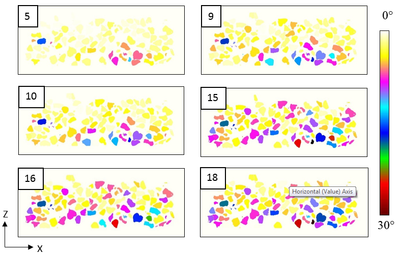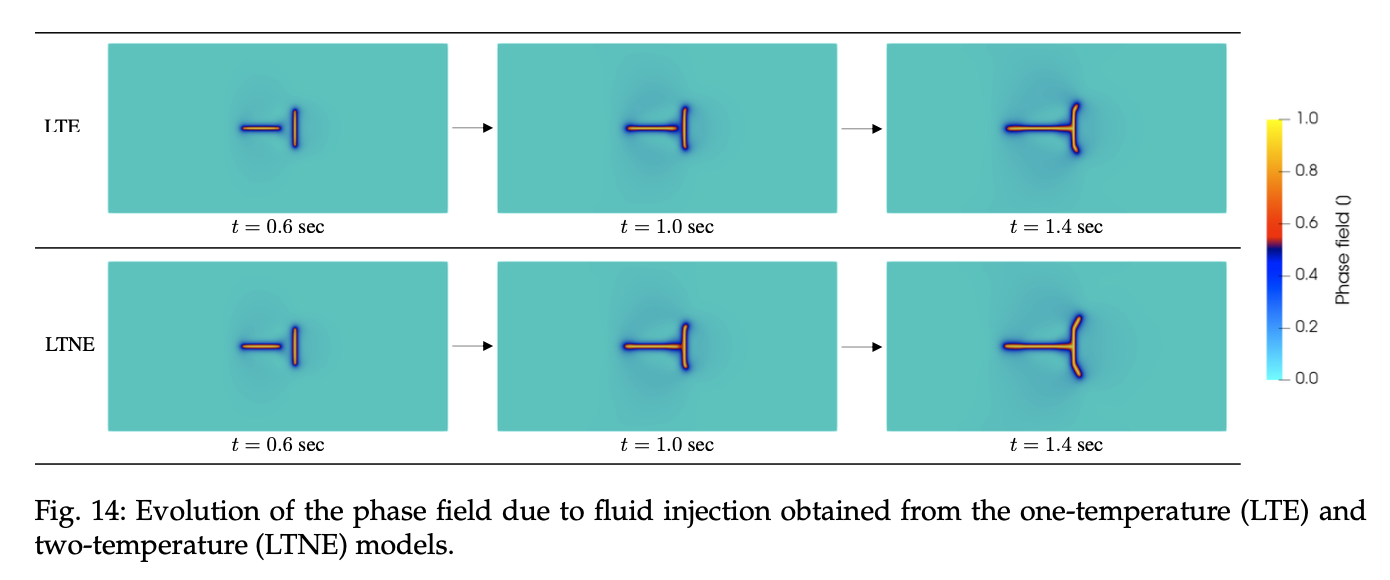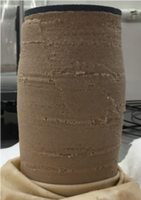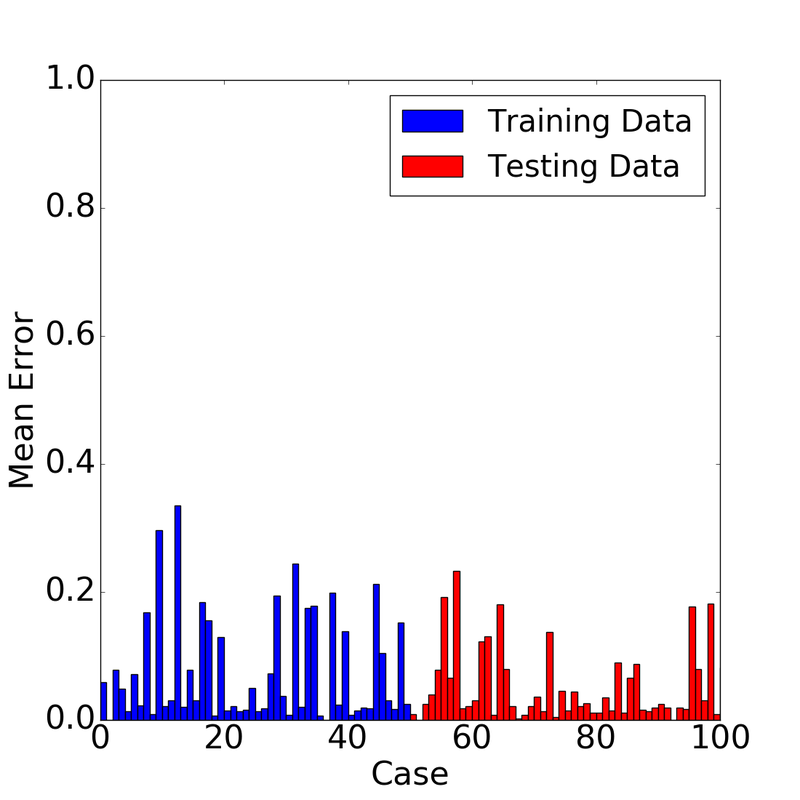|
Our team member and PhD student SeonHong Na has sucessfully defended his PhD thesis which entitled "Multiscale thermo-hydro-mechanical-chemical (THMC) coupling effects for fluid-infiltrating dual-porosity crystalline rock: theory, implementation, and validation" is examined by the committee consisted of Professor Hoe Ling (CEEM), Professor Ioannis Kougioumtzoglou (CEEM), Professor Greard Ateshian (ME), Dr. Moo Lee & Dr. Hongkyu Yoon (Sandia National Laboratories). We thank all the committee members for their insightful questions, comments and time. SeonHong Na joined the research group in 9/2014. His thesis focuses on the computational mechanics of geological media in extreme environments. His work is supported by ARO, DOE, Columbia and Fulbright Fellowship. During his study at Columbia, SeonHong has won numerous awards, including two Teaching Assistance Excellence Awards, the Mindlin Scholarship, Dongju Lee Memorial Award, and the 2nd place from the ASCE EMI Modeling Inelasticity & Multiscale Behavior poster competition, among others. His achievement and contribution to our research group are exemplified in the thesis and the published papers, which are listed below. Published Work:
0 Comments
7/23 #2021543 - Dual-basis Dimensional Reduction for Non-dissipative Explicit Dynamic Discrete Element Simulations with High-frequency Noises 10:45 - 11:05 Minisymposium#1701 Computational Geomechanics AuthorsKun Wang ,Xinran Zhong* ,WaiChing Sun LocationRoom # Barrymore - MM-9We present, for the first time, a dimensional reduction model based on proper orthogonal decomposition (POD) for non-dissipative explicit dynamic discrete element method (DEM) simulations. Two individual POD bases are obtained by the method of snapshots for the displacement and rotation degrees of freedom of the discrete element particles, respectively. The POD basis for rotation is extracted from the vector space of angular velocity. Since the rotation vectors are pseudovectors which adopt a different algebra, explicit Lie-group time integrator is introduced for the integration of particle rotations, while the time integrator for the displacement field is in the Euclidean space. As such, the two set of snapshots are taken from the simulations with numerically dissipative schemes. Then the derived reduced dimension bases are employed in energy-momentum conserving DEM simulations. This approach brings four important benefits. First, one may filter out the high-frequency noises and obtain accurate results without introducing artificial damping that sometimes leads to inconsistent results and reduced wave propagation speed. Second, the number of snapshots used for displacement and rotation can be different, depending on the nature of the problems. Third, since this method requires no injection of artificial or numerical damping, there is no need to tune damping parameters Finally, the suppression of high-frequency responses allows larger time step for faster explicit integration. The proposed POD-DEM scheme is important for analyzing wave propagation, mixing, rate-dependent simulations for particular materials in which how the external work applied on the system converts into internal energy and dissipation are critical to the outcomes. #2019101 - Unified modeling framework for brittle, quasi-brittle, and ductile failures of pressure-sensitive rocks 14:20 - 14:40 Minisymposium#1701 Computational Geomechanics Authors Jinhyun Choo (now assistant professor at HKU)* ,WaiChing Sun LocationRoom # Barrymore - MM-9Rocks display a wide range of failure modes depending on the confining pressure. The failure mode is localized and brittle fracture under a low confining pressure, but it increasingly becomes more diffuse and ductile as the confining pressure increases. Moreover, it has been shown that a rock under tensile loading can show a hybrid fracture mode in which tensile and shear fracture modes are mixed. Nevertheless, existing computational models usually focus on one of these failure modes. This talk will introduce a recently developed computational framework for unified modeling of these different failure modes under a wide range of confining pressure [1]. The framework couples a phase-field approach to fracture and pressure-sensitive plasticity. By doing so, it can capture the brittle failure mode using a phase-field approach, whereas it can simulate the ductile failure mode by plasticity. The coupling of phase-field and plasticity also allows for simulating quasi-brittle shear fracture and hybrid fracture as observed from experiments. The key ideas of this new coupling, such as the use of phase-field effective stress, will be discussed. Reference: [1] Choo, J. and Sun, W. C. (2018). Coupled phase-field and plasticity modeling of geological materials: From brittle fracture to ductile flow. Computer Methods in Applied Mechanics and Engineering, 330, 1–32. #2021537 - Modeling High-strain-rate Responses Brittle Porous Media with Fracture Opening and Closure 14:20 - 14:40 Minisymposium#212 Variational Fracture Modeling for Brittle and Ductile Materials Authors SeonHong Na*, WaiChing Sun LocationRoom # Brecht - MM-4In engineering applications that involves impacts, earthquake, and explosion, geomaterials are subjected to unusually high strain rate loading. This high strain rate leads to material responses significantly different than the quasi-static counterpart. The competition between elastic wave propagation and fracture propagation often leads to complex features, such as multiple fracture branches, coalescence, and closure. These mechanisms in return affect the two-way hydro-mechanical coupling between the fractured solid skeleton and the pore fluid. In this work, we use an implicit function to approximate cracks to dynamic crack growth and closure in brittle porous materials under high-strain-rate loading. To model the crack opening, closing, and slip behaviors under the dynamic conditions, we introduce a homogenization procedure to convert interface plasticity for strong discontinuity to a regularized anisotropic plasticity model with nonlocal plastic flow aligned with the gradient of the phase field. Both the two-field u-p and the three-field u-w-p and u-U-p formulations are implemented. The results are compared in numerical experiments. #2021515 - A Multi-phase-field/Polycrystal Plasticity for the Brittle-ductile Transitions of Crystalline Rock with Precipitating Fluid 14:40 - 15:00 Minisymposium#1701 Computational Geomechanics Authors SeonHong Na* ,WaiChing Sun LocationRoom # Barrymore - MM-9A safe and permanent repository for nuclear waste disposal using rock salt has drawn attention due to increasing demand of a sustainable and clean energy. The usage of rock salt for the geological repository is highly related to its desired characteristics, such as high thermal conductivity, low permeability and self-healing mechanism. These complicated physical and chemical mechanisms are closely related to the microscopic properties of rock salt. Previous efforts for investigating rock salt have focused on capturing the phenomenological behaviors. Nevertheless, the induced anisotropy and the rate-dependent behaviors of polycrystalline salt are often originated from the microstructures. In this work, we present an alternative approach in which the crystalline nature and the migration of brine as inclusions and precipitated fluid along the ground boundaries are explicitly modelled. We formulate a phase field framework for rock salt that explicitly model the interactions among crystal grain, grain boundaries and brine inclusions. A multi-phase-field method to capture brine migration due to dissolution and precipitation mechanism of halite under temperature gradient. Meanwhile, the crystal plasticity theory is adopted for modeling each grain to account for the crystallographic properties of rock salt. The texture of the multi-grains of salt is assumed to be random by assigning different sets of orientations to each grain. Numerical examples demonstrate that the proposed model is able to capture the brine migrations, interactions of the brine inclusion inside the halite grain and the fluid precipitating in grain boundaries. 7/24 #2021780 - Deep-learning Enhanced Computational Failure Mechanics across Multiple Scales 10:45 - 11:05 Minisymposium#1701 Computational Geomechanics Authors WaiChing Sun* LocationRoom # Barrymore - MM-9We introduce a new hybridized deep-learning/material modeling framework to capture localized failures, in particular, shear bands and fracture across multiple length scales. This modeling framework introduces deep learning as a mean to connect simulations and data across different scales through recursive homogenization. Directed graph, a concept to analyze the hierarchy of information will be used to generate optimal configurations of hybrid deep-learning/material models for a given set of data across length scale such that the effects of evolving microstructures due to micro-cracks, plastic slip and wear can be propagated to the macroscopic scales. To ensure efficiency, an ensemble of theoretical and deep-learning-based material models of different sophistication will be used to predict constitutive responses within a phase field framework. Each phase field represents the weights of a model of a particular scale in the ensembled constitutive predictions. By evolving the phase fields, the ensemble predictions will always capture the domain of interests, such as the moving crack tips during crack growth or shear bands forming in the softening regime, with the most sophisticated predictions, while the far field predictions will be adaptively simplified for efficiency. These evolutions of the phase fields in the space-time continuum is controlled by the driving force. This driving force is a scalar function that depends on the results of validations. Meanwhile, unconventional information from the microstructures, such as coordination number, fabric tensors, void size distribution, grain size distribution, will be analyzed and put into the directed graph that represents the hybridized constitutive laws without hand-crafting new phenomenological models as surrogates. #2021560 - Computational Unsaturated Poromechanics Enhanced by Deep Learning 11:05 - 11:25 Minisymposium#1701 Computational Geomechanics Authors Kun Wang ,Nikolaos Vlassis* ,WaiChing Sun LocationRoom # Barrymore - MM-9Many engineering applications and geological processes involve unsaturated porous media across multiple length scales (e.g. rock joints, grain boundaries, deformation bands, and faults). Understanding the multiscale path-dependent hydro-mechanical responses of these interfaces across length scales is of ultimate importance for applications such as CO2 sequestration and hydraulic fracture. Nevertheless, unlike the saturated counterpart, the path-dependent behaviors of the unsaturated porous media may originate from both the irreversible damage and plasticity of the solid skeleton, the hysteresis of the water retention behaviors and the resultant path-dependent hydraulic responses. For convenience, numerical models often neglect the hysteresis effect of the retention curves. This simplification often leads to unrealistic predictions. In this work, we introduce a hybrid hand-crafted/machine-learning model in which we combine a class of recurrent neural network model (based on long-short-term-memory neuron) that replicates the path-dependent water retention behaviors and classical constitutive critical state plasticity model to replicate the hydro-mechanical responses of unsaturated porous media. This approach allows one to bypass the need of deriving complex phenomenological law for the portion of the constitutive model that lacks clean physical underpinnings while retaining the part of the model that can be justified with sufficient physical arguments (e.g. critical state plasticity). A set of numerical experiments are used to demonstrate the robustness of the proposed model. #2021544 - A Modified Phase Field Model for Mixed-mode Crack Propagation with Consistent Kinematic Modes 11:25 - 11:45 Minisymposium#1701 Computational Geomechanics Authors Eric Bryant* ,WaiChing Sun LocationRoom # Barrymore - MM-9 Cracks in brittle, isotropic, homogeneous materials often propagate such that the pure Mode I kinematic mode is maintained at the crack tip. However, numerous geo-materials, such as sedimentary rock, shale, mudstone, concrete and gypsum, the Mode I and Mode II critical fracture energies are distinct. In such cases, it is likely that secondary Mode II and mixed-mode propagation may occur. This has previously been exhibited by experiments where wing cracks and secondary cracks develop from pre-existing flaws under a combination of shear and tensile or shear and compressive loadings. To capture the mixed-mode fracture propagations, a mixed-Mode I/II fracture model that employs multiple critical critical energy release rates based on Shen and Stephansson, IJRMMS, 1993 is adopted in a phase field framework. Within each incremental time step, an explicit-implicit operator-split scheme is used such that a local energy minimization problem is solved such that the crack propagation direction and the corresponding kinematics modes are determined. This step is followed by the update of the phase field and that of the displacement. Several numerical examples that demonstrated the Mode II and mixed mode crack propagations in brittle materials are presented. Possible extensions of the model that captures the degradation related to shear/compressive damage commonly observed in sub-surface applications and triaxial compression tests are discussed. 7/27 #2021536 - Hybridizing Neural Network and Hand-crafted Critical State Plasticity Model for Forward Prediction of Geomaterials in a Directed Graph 13:40 - 14:00 Minisymposium#1708 Constitutive Modeling of Geomaterials: Development, Implementation, and Performance Assessment Authors Kun Wang* ,WaiChing Sun LocationRoom # Lyceum - Marriott Marquis-5This work presents a novel component-based approach on the development of constitutive models for materials having complex path-dependent mechanical properties. Critical state plasticity models for capturing the complex cyclic response of sands have been proposed, yet lack the prediction accuracy against experiments. To extend the capability of the existing models, we propose the introduction of machine learning on experimental data into the conventional plasticity formulations. The directed graphs of the constitutive models are constructed, with the nodes representing the physical quantities (stress, strain, porosity, fabric tensor, etc.) and the edges representing the universal principles, definitions or constitutive equations relating these quantities. The discrepancy between the different constitutive models lies in the configuration of the directed graphs. The fully mathematical plasticity model involves yield surfaces, plasticity potentials, and evolution equation of internal variables. The fully data-driven constitutive model relates the stress to strain directly via the neurons in the artificial neural networks conserving material frame indifference. The development of hybrid data-driven plasticity model consists of selective replacement of mathematical formulation by machine learning. The choices of data-driven nodes and edges in the directed graph result in different configurations, hence lead to different hybrid models. We present a group of model designs with various degree of hybridization and compare them against experimental data on cyclic responses of sands. Their accuracy and computational efficiency are compared within our proposed model evaluation framework. This work offers the community a novel graph-based systematic approach on developing and assessment of hybrid data-driven constitutive models. These research are supported by the Columbia University 2018 Interdisciplinary Research Seed funding program, Army Research Office under grant contracts W911NF-15-1-0442 and W911NF-15-1-0581, Air Force Office of Scientific Research under grant contract FA9550-17-1-0169, the nuclear energy university program from department of energy under grant contract DE-NE0008534 as well as the Mechanics of Materials and Structures program at National Science Foundation under grant contract CMMI-1462760. We gratefully acknowledge the listed supports. The views and conclusions contained in this document are those of the authors, and should not be interpreted as representing the official policies, either expressed or implied, of the sponsors, including the Army Research Laboratory or the U.S. Government. The U.S. Government is authorized to reproduce and distribute reprints for Government purposes notwithstanding any copyright notation herein.
Title:
Open-source support toward validating and falsifying discrete mechanics models using synthetic granular materials Part I: Experimental tests with particles manufactured by a 3D printer Author: Ritesh Gupta, Simon Salager, Kun Wang and WaiChing Sun Abstract: This article presents a new test prototype that leverages the 3D printing technique to create artificial particle assembles to provide auxiliary evidences that supports the validation procedure. The prototype test first extracts particle shape features from micro-CT images of a real sand grain and replicates the geometrical features of sand grain using a 3D printer. The quantitative measurements of the particle shape descriptors reveal that the synthetic particles inherit some attributes such as aspect ratio and sparseness of the real materials while exhibiting marked differences for sphericity and convexity. While it is not sufficient to consider the printed particle assembles a replica of the real sand, the repeatable manufacture process provides convention tools to generate additional data that supports the validation procedure for particulate simulations. Oedometric compression tests are conducted on a specimen composed of the printed particles of identical size and shape to create benchmark cases for calibrating and validating discrete element models. Results from digital image correlation on the synthetic sand assemblies reveal that the fracture and fragmentation of the synthetic particles are minor, which in return makes particle position tracking possible. As our prototype test and research data are designed to be open-source, the dataset and the prototype work will open doors for modelers to design further controlled experiments using synthetic granular materials such that the individual influence of each morphological feature of granular assemblies (e.g. shape and size distribution, void ratio, fabric orientation) can be individually tested without being simultaneously affected by other variables. [PDF] Our research group has received a three-year grant from Army Research Office to study the formation of ice lens and the thawing plasticity of frozen soils. In collaboration with the cold regions research and engineering laboratory of US Army Corps of Engineers, our goal is to formulate a new model that predicts the evolution of ice lens. We also introduce a new validation metric to analyze the model performance in matching calibrated results and making forward predictions. In particular, we have identified modeling components that lead to seemingly excellent calibrations but does not provide real benefits for forward prediction ability (LEFT figure) and proposed remedies to enforce the consistency and robustness in the models (RIGHT figure). With this new start point, we introduce inverse problems and models to capture the growth of the ice lens and the corresponding implications on geosystems. |
Group NewsNews about Computational Poromechanics lab at Columbia University. Categories
All
Archives
July 2023
|




















 RSS Feed
RSS Feed